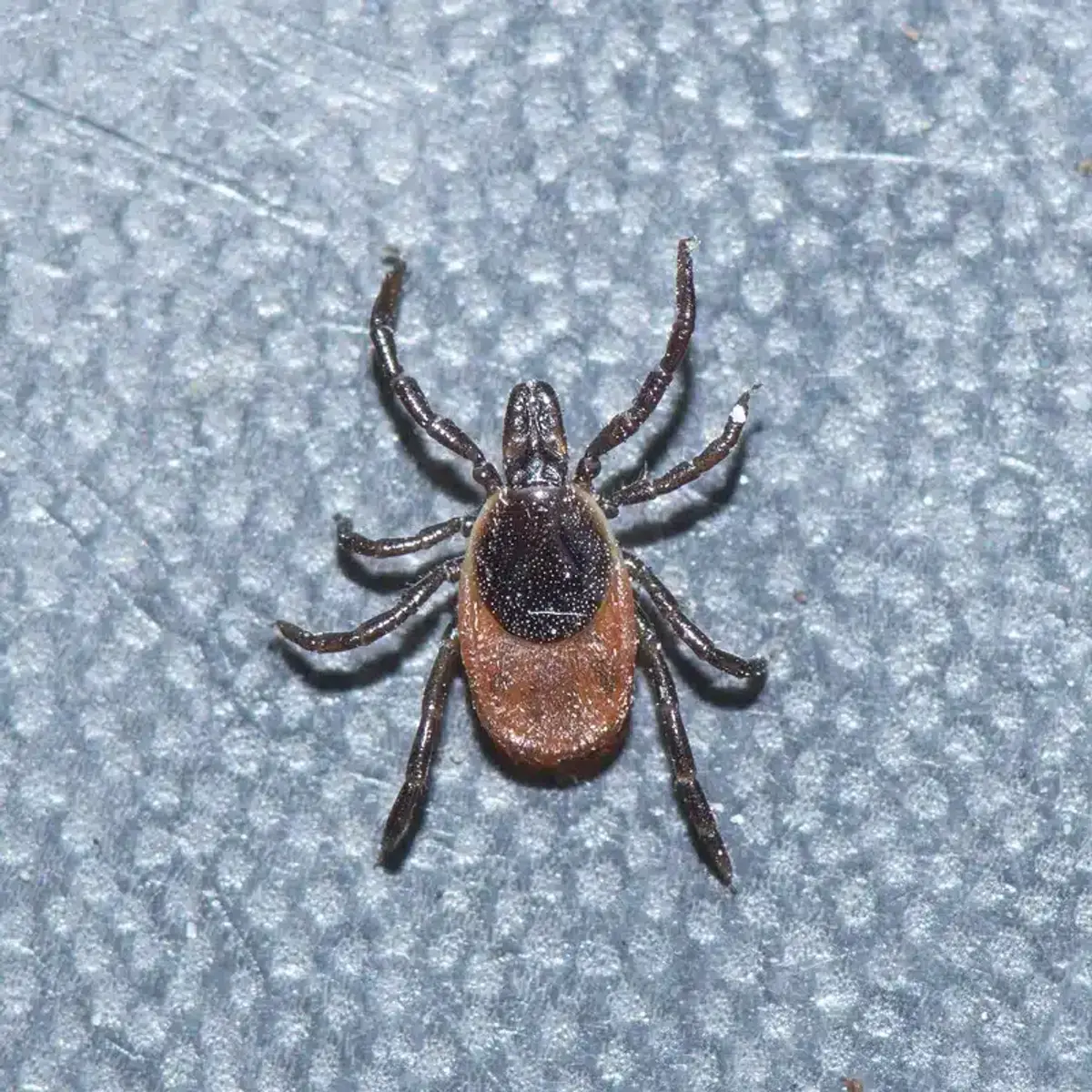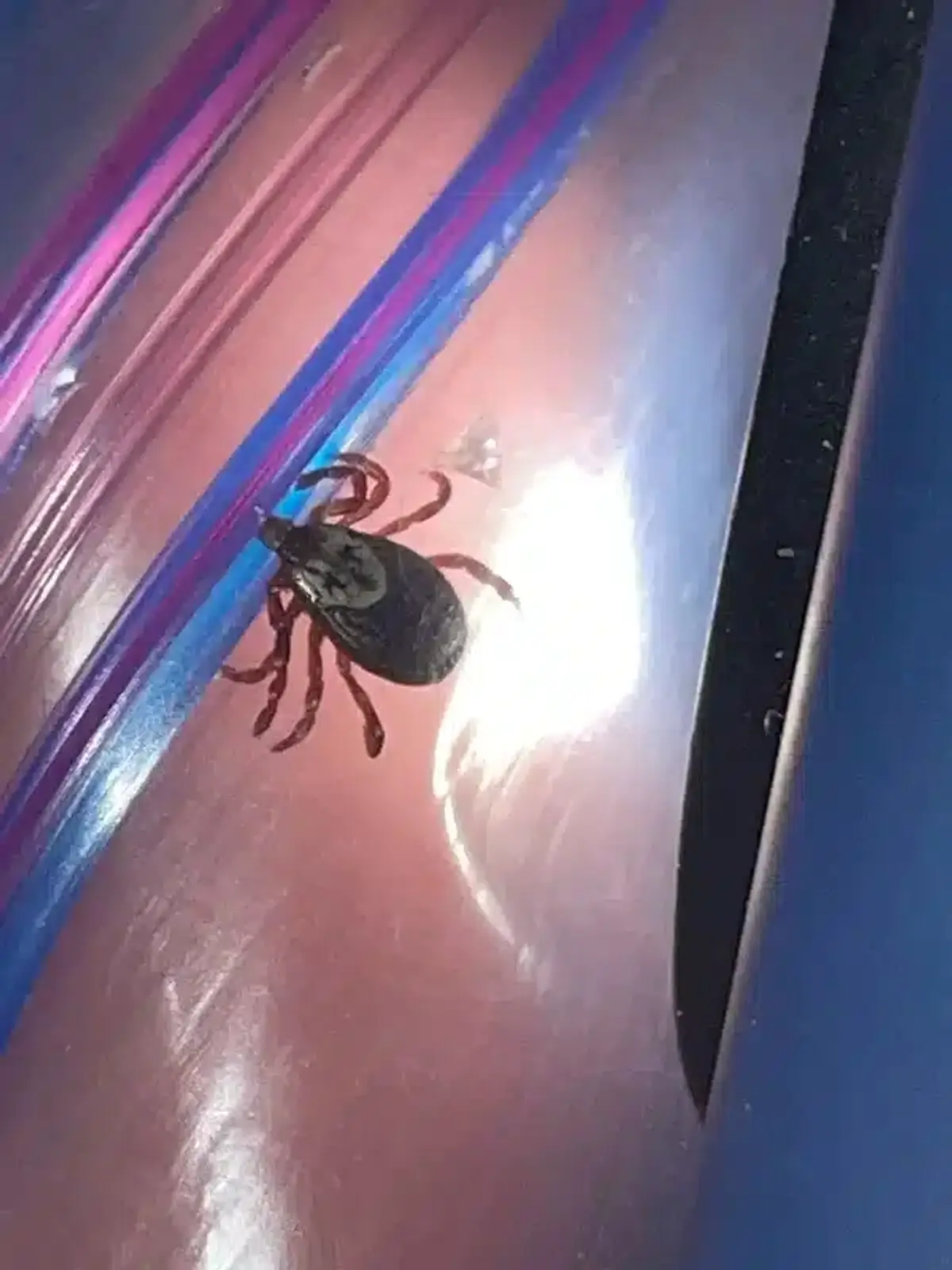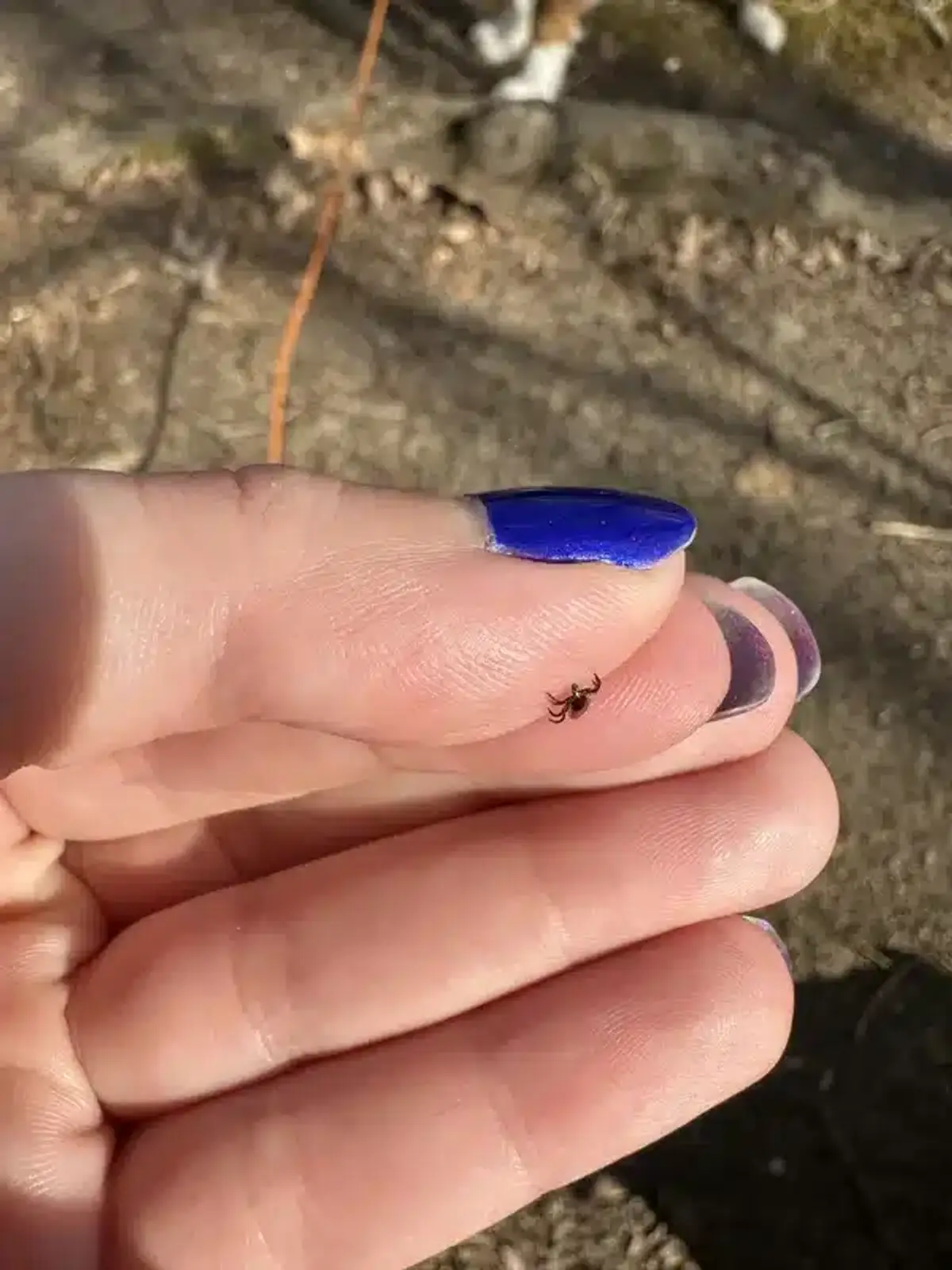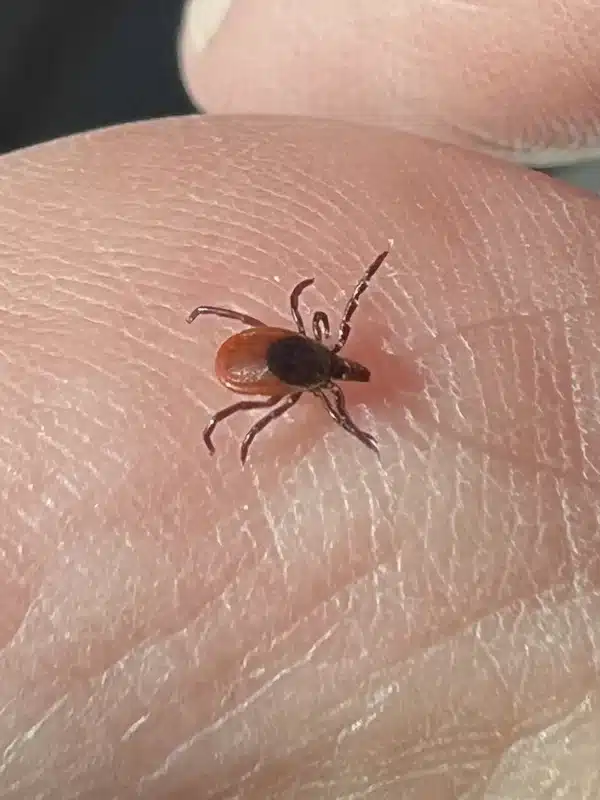Maryland Tick Statistics
The reality is that Maryland sits right in the heart of tick territory. Our state has become a mixing zone where multiple dangerous tick species overlap, creating serious health risks for residents. With Lyme disease cases surpassing 2,000 confirmed cases in 2022 and approaching 2,500 in 2023, Maryland’s Governor even proclaimed May 2025 as “Tick-Borne Disease Awareness Month.”

If you’ve ever stepped into a field and come back with multiple ticks on your legs, you know how quickly these tiny threats can find you. I experienced this firsthand during a road trip when I had to pull over and walk into what seemed like an ordinary field. Within minutes, I discovered four ticks crawling up my leg. That moment really drove home how easily you can encounter ticks in Maryland - not just in deep forests, but in everyday outdoor spaces like grassy areas and open fields.
Common Tick Species in Maryland
Maryland hosts three primary tick species that pose health risks to humans and pets. Each species carries different diseases and has distinct identification features that can help you recognize what you’re dealing with.
| Species | Size | Primary Diseases | Peak Activity |
|---|---|---|---|
| Black-legged (Deer Tick) | 3mm unfed | Lyme Disease | October - May |
| American Dog Tick | 5mm unfed | Rocky Mountain Spotted Fever | April - August |
| Lone Star Tick | 4-6mm unfed | Ehrlichiosis, Alpha-gal | April - August |
Black-legged Ticks (Deer Ticks)
Black-legged ticks are the primary carriers of Lyme disease in Maryland. These tiny parasites measure about 3 mm when unfed and can expand to 10 mm when engorged with blood. Adults remain active year-round during warm spells, but peak activity occurs from October through May.
The most dangerous stage is actually the nymph, which is active from May through August. Nymphs are only about 2 mm in size - roughly the size of a sesame seed - making them extremely difficult to spot.
What does the science say? 🔬
According to the University of Maryland Extension, these nymphs pose the highest infection risk because they’re so small that people often don’t notice them. Research shows that the tiny size of nymphs, combined with their peak activity during warm weather when people spend more time outdoors, creates the perfect storm for disease transmission.

American Dog Ticks
American dog ticks are larger than deer ticks, measuring about 5 mm unfed and expanding up to 15 mm when engorged. They’re the primary carriers of Rocky Mountain spotted fever in Maryland, along with tularemia and tick paralysis.
These ticks are most active from April through early August. Adults prefer to attach to larger hosts like dogs and humans, while their nymphs typically feed on small rodents from May through July.

Lone Star Ticks
Lone star ticks are aggressive biters that will attack humans in all life stages. Female lone star ticks are easily identified by the single white spot on their backs. They measure 4-6 mm when unfed and are active from April through late August.
What makes lone star ticks particularly concerning is their ability to transmit ehrlichiosis and cause alpha-gal syndrome - a condition that can make you allergic to red meat. These ticks have been expanding their range northward and are now found throughout Maryland, including western counties.


Understanding Tick Life Stages and Identification
All ticks go through four life stages: egg, larva, nymph, and adult. Understanding these stages helps you identify what you’re looking at and assess the potential risk.
Larvae have six legs and are about 1 mm in size - roughly the size of a poppy seed. They typically stay in leaf litter and feed on small rodents. Larvae generally don’t pose disease risks because they haven’t had a chance to pick up pathogens yet.
Nymphs have eight legs and measure 2-3 mm - about the size of a sesame seed. They’re found in leaf litter and low vegetation and represent the highest infection risk to people because they’re so difficult to spot.

Adults also have eight legs and range from 3-5 mm unfed - about the size of an apple seed. When engorged with blood, females can expand to grape-like proportions of 10 mm or more. Adults are easier to spot but can still transmit serious diseases.
Tick-Borne Diseases in Maryland
The diseases carried by ticks in Maryland can have serious, long-lasting health impacts. Understanding these diseases helps you recognize symptoms and seek prompt medical attention when necessary.
Lyme Disease
Lyme disease is by far the most common tick-borne illness in Maryland, with over 2,000 cases reported annually. It’s transmitted primarily by black-legged tick nymphs and adults.
What does the science say? 🔬
According to the Maryland Department of Health, some western Maryland counties now show tick infection rates around 40%. This alarming statistic demonstrates why Maryland has become a hotspot for Lyme disease transmission, with infection rates significantly higher than the national average in certain regions.
Early symptoms include fever, chills, headache, fatigue, and often a characteristic “bull’s-eye” rash. If left untreated, Lyme disease can cause serious joint, heart, and nervous system problems.
Rocky Mountain Spotted Fever
Rocky Mountain spotted fever is transmitted primarily by American dog ticks. While less common than Lyme disease, it can be fatal if not treated promptly. Symptoms include sudden onset of fever, headache, and muscle aches, often followed by a spotted rash.
Ehrlichiosis
Ehrlichiosis is transmitted by lone star ticks and causes flu-like symptoms including fever, headache, and muscle aches. Cases tend to cluster in southern Maryland and Eastern Shore wooded areas where lone star tick populations are highest.
Alpha-Gal Syndrome
Alpha-gal syndrome is a delayed allergic reaction to red meat that can be triggered by lone star tick bites. This condition has gained significant media attention recently as more cases are identified. The allergic reaction can occur 3-6 hours after eating red meat and may include hives, swelling, and digestive problems.
Peak Tick Season in Maryland
While ticks can be active year-round during warm spells, peak tick season in Maryland runs from April through September. This coincides with when people spend the most time outdoors and when tick nymphs are most active.
The highest risk period is actually late spring and early summer when tiny nymphs are questing for hosts. According to Southern Maryland research, human bite risk peaks during this period because nymphs are so difficult to detect.
However, it’s important to remember that Maryland’s mild winters mean adult black-legged ticks can be active on any day when temperatures reach 40°F or higher. Basically, tick season never truly ends in our state.
High-Risk Areas for Ticks in Maryland
Not all outdoor areas carry equal tick risk. Understanding where ticks are most likely to be found helps you take appropriate precautions during outdoor activities.
Western Maryland
Western Maryland’s forested ridges in Allegany and Garrett counties represent some of the highest tick activity areas in the state. Research shows that approximately 40% of collected ticks in these areas carry Lyme disease, according to Maryland Department of Natural Resources studies.
Suburban Areas
The suburban Piedmont region, including Carroll and Howard counties, creates ideal edge habitat where ticks thrive. These areas combine deer corridors with landscaping features like ornamental barberry that provide perfect tick habitat.
Southern Maryland and Eastern Shore
Sandy soils and loblolly pine thickets in southern Maryland and the Eastern Shore create favorable conditions for lone star ticks. These areas also support the small mammals that serve as tick hosts during their early life stages.

Specific Micro-Habitats
Within any area, ticks concentrate in specific micro-sites including leaf litter, stone walls, woodpiles, overgrown lawn edges, and tall ornamental grasses. These spots provide the humidity and protection ticks need while positioning them to encounter passing hosts.
Proper Tick Removal Techniques
If you find a tick attached to your skin, proper removal is crucial to minimize disease transmission risk. The longer a tick remains attached, the higher the chance of disease transmission.
Use fine-tipped tweezers to grasp the tick as close to your skin as possible. Pull upward with steady, even pressure - don’t twist or jerk the tick. Avoid crushing the tick’s body during removal because this can push infected fluids into the bite wound.
After removing the tick, clean the bite area and your hands thoroughly with soap and water or alcohol. You can dispose of the tick by placing it in alcohol, sealing it in a bag, wrapping it tightly in tape, or flushing it down the toilet.
Never use matches, nail polish, or petroleum jelly to try to remove a tick. These folk remedies can actually cause the tick to release more infected saliva into your skin.
Monitor the bite site for 30 days and watch for symptoms like fever, rash, or flu-like illness. Contact your healthcare provider if you develop any concerning symptoms.
Tick Prevention Methods for Maryland Residents
The best defense against tick-borne diseases is preventing tick bites in the first place. Multiple prevention strategies work together to significantly reduce your risk.
Essential Prevention Steps
- Protective Clothing: Wear light-colored, long-sleeved shirts and pants; tuck pants into socks to create barriers.
- EPA-Registered Repellents: Use DEET, picaridin, or permethrin products with 30% or higher concentration.
- Trail Safety: Stay in the center of paths, avoid brushing against vegetation where ticks quest for hosts.
- Post-Activity Checks: Perform thorough body checks and shower within 2 hours of outdoor activities.
Protective Clothing
Wear light-colored clothing so you can easily spot ticks. Long sleeves and pants provide physical barriers, and tucking your pants into your socks creates an additional obstacle for ticks trying to reach your skin.

Repellents
Use EPA-registered repellents containing DEET, picaridin, IR3535, 2-undecanone, or oil of lemon eucalyptus with concentrations of 30% or higher.
What does the science say? 🔬
According to CDC guidelines, these repellents provide effective protection when applied correctly. Clinical studies show that DEET and picaridin-based repellents can provide 7-10 hours of protection against tick attachment when used as directed, making them the gold standard for tick bite prevention.
For children under 3 years old, avoid products containing oil of lemon eucalyptus or PMD. Always follow label instructions for safe application.
Permethrin Treatment
Treat clothing and gear with 0.5% permethrin spray, which kills ticks on contact. Permethrin-treated clothing remains effective through multiple washings and provides excellent protection for outdoor enthusiasts.
Behavioral Precautions
Stay in the center of trails and avoid brushing against vegetation where ticks quest for hosts. When possible, sit on rocks rather than logs, and avoid walking through tall grass or leaf litter.
Post-Outdoor Activity Tick Checks
Thorough tick checks after outdoor activities are essential because you might pick up ticks even in areas where you don’t expect them.
Four Ticks in an Ordinary Field
During a routine road trip, I experienced firsthand how quickly tick encounters can happen. What seemed like an ordinary field stop turned into an eye-opening lesson about tick behavior and habitat.
- The situation: Brief stop in what appeared to be a normal open field.
- Time exposed: Only a few minutes walking through the area.
- Discovery: Found four ticks crawling up my legs within minutes.
- Key lesson: Tick encounters can happen anywhere, not just deep forests.
This experience reinforced that tick encounters happen faster than most people think, even in areas where you wouldn’t expect them.
Shower within two hours of coming indoors when possible. The warm water and scrubbing can help remove unattached ticks. Additionally, put outdoor clothes in the dryer on high heat for 10 minutes to kill any hidden ticks.
Check your entire body systematically, paying special attention to the scalp and hairline, armpits, waistband area, behind the knees, groin area, and around the ears. For children, also check behind the ears and along the hairline carefully.
Don’t forget to check your pets thoroughly after they’ve been outdoors. Ticks can easily transfer from pets to humans, and pets can bring ticks into your home where they might later find human hosts.
Professional Tick Control for Maryland Properties
While personal protection is crucial, professional tick control can significantly reduce tick populations on your property. Licensed applicators can apply targeted treatments that create protective barriers around your home.

Professional treatments typically focus on the ecotone - the transition area between your maintained lawn and natural vegetation where ticks are most likely to encounter humans. We complete targeted applications during peak tick activity periods in spring and fall.
Our approach includes granular applications in March and November when tick populations spike, plus monthly topical sprays from April through October to the areas where landscaping transitions to more natural terrain. Additionally, we use specialized tick tubes containing permethrin-treated cotton that mice collect for nesting, which kills young ticks feeding on these hosts.

For areas like Silver Spring, Rockville, and College Park, professional treatment becomes especially important because suburban development creates ideal edge habitat for multiple tick species.
Yard Management and Habitat Modification
Creating an environment that’s less attractive to ticks can significantly reduce their numbers on your property. Simple landscape modifications make a big difference in tick populations.
Keep grass cut to less than 4 inches and remove leaf litter and brush from around your home. Create a 3-foot dry barrier of gravel or wood chips between your lawn and wooded areas to discourage tick migration into your yard.
Discourage deer from your property through fencing or deer-resistant plantings. Since deer are primary hosts for adult ticks, reducing deer activity around your home cuts down on tick populations.
Remove brush piles, tall grass, and weedy areas where small mammals might shelter. These animals serve as hosts for immature ticks, so reducing their habitat helps break the tick life cycle.
According to University of Maryland Extension, ecological landscaping combined with personal protection measures offers better results than relying solely on blanket yard insecticides.
Special Considerations for Maryland Pet Owners
Pet owners face additional challenges because dogs and cats can easily pick up ticks and bring them into the home. Year-round veterinary tick preventives are essential, though no single product provides 100% effectiveness.
After walks or outdoor time, comb through your pet’s fur thoroughly, paying special attention to the ears, neck, and areas where the collar sits. Check between toes and around the tail area where ticks often attach.
Keep dogs out of tall grass when possible, and consider tick identification training so you can recognize different species you might find on your pets.
Brown dog ticks can actually establish indoor infestations, particularly in heated homes during winter. If you suspect indoor tick activity, professional help may be necessary because these infestations can be difficult to eliminate without proper treatment.
Remember that pets can also suffer from tick-borne diseases, including Lyme disease and ehrlichiosis. Watch for symptoms like lethargy, loss of appetite, or lameness, and consult your veterinarian if you notice any concerning changes.
Outdoor Enthusiasts and High-Risk Activities
Hikers, hunters, trail runners, and other outdoor enthusiasts face elevated tick exposure risks. Understanding how to protect yourself during high-risk activities is crucial for enjoying Maryland’s outdoor spaces.
For hiking and trail running, consider permethrin-treated socks and gaiters, which provide excellent protection for your lower legs where most tick encounters occur. Plan your route to stay in the center of well-maintained trails when possible.
Turkey and deer hunters spend extended periods in prime tick habitat during peak activity seasons. Use the “tick check buddy system” to help spot ticks in hard-to-see areas, and perform checks during breaks in activity rather than waiting until the end of the day.
Campers and fishers around tidal creeks should be aware that ticks quest on waist-high marsh grass, particularly around popular spots like campfire rings where people frequently brush against vegetation.
Consider the visual identification resources that can help you recognize the different tick species you might encounter in various Maryland habitats.
Emerging Tick Threats and Research
The tick situation in Maryland continues to evolve as climate change and other factors affect tick populations and disease transmission patterns. Understanding these trends helps you stay prepared for emerging threats.
Co-infection is becoming increasingly common, with up to one in five black-legged ticks in some Maryland studies carrying multiple pathogens. This complicates diagnosis and treatment because symptoms from different diseases can overlap or mask each other.
Lone star ticks are expanding their range northward and now overwinter successfully in western Maryland counties where they were previously uncommon. This expansion brings increased risk of ehrlichiosis and alpha-gal syndrome to areas that didn’t previously face these threats.
Citizen science programs like Frostburg State University’s “Tick Talk” research project demonstrate how community involvement helps track tick population changes and disease prevalence across the state. These programs provide valuable data that informs public health recommendations.
Protecting Your Family from Maryland Ticks
Dealing with ticks in Maryland requires a comprehensive approach that combines personal protection, property management, and awareness of when professional help makes sense. The combination of Maryland’s climate, diverse habitats, and multiple tick species creates ongoing challenges that require vigilant attention.
Remember that tick encounters can happen anywhere - from deep forests to suburban yards to open fields. My own experience finding multiple ticks after a brief stop in what seemed like an ordinary area reinforced how quickly these encounters can occur.
The most effective protection comes from layering multiple strategies: using appropriate repellents, wearing protective clothing, performing thorough tick checks, managing your property’s tick habitat, and considering professional treatment for high-risk areas.
Don’t let fear of ticks prevent you from enjoying Maryland’s beautiful outdoor spaces. With proper knowledge and preparation, you can significantly reduce your risk while still participating in hiking, camping, gardening, and other outdoor activities that make living in Maryland so rewarding.
If you’re dealing with tick problems on your property or want to establish a protective barrier around your home, professional treatment can provide peace of mind and effective results. Our experienced team understands the specific challenges of Maryland tick control and can develop a customized approach for your property’s unique needs.
For questions about tick identification, prevention strategies, or professional tick control options for your Maryland property, call us at 703-683-2000 or email us at info@bettertermite.com. Our licensed technicians can provide personalized recommendations based on your specific situation and location.
Frequently Asked Questions
When is tick season in Maryland?
+
Peak tick season in Maryland runs from April through September, but ticks can be active year-round during warm spells. Adult black-legged ticks are particularly active on any day when temperatures reach 40°F or higher, which means tick season never truly ends in Maryland.
What types of ticks are found in Maryland?
+
Maryland hosts three primary tick species: black-legged ticks (deer ticks) that carry Lyme disease, American dog ticks that transmit Rocky Mountain spotted fever, and lone star ticks that cause ehrlichiosis and alpha-gal syndrome. Each species has different activity periods and health risks.
How do I properly remove a tick?
+
Use fine-tipped tweezers to grasp the tick close to your skin and pull upward with steady pressure. Don't twist or jerk the tick, and avoid crushing its body. Clean the area with soap and water or alcohol after removal. Never use matches, nail polish, or petroleum jelly to remove ticks.
What diseases do ticks carry in Maryland?
+
Ticks in Maryland transmit several serious diseases including Lyme disease, Rocky Mountain spotted fever, ehrlichiosis, babesiosis, anaplasmosis, and tularemia. Lone star ticks can also trigger alpha-gal syndrome, which causes allergic reactions to red meat.
Where are ticks most commonly found in Maryland?
+
Ticks are most common in wooded areas, tall grass, leaf litter, and edge habitats where lawns meet natural vegetation. Western Maryland forests, suburban areas with deer activity, and southern Maryland woodlands represent the highest-risk areas in the state.
How can I prevent tick bites?
+
Wear light-colored clothing with long sleeves and pants, use EPA-registered repellents with DEET or picaridin, treat clothing with permethrin, stay in the center of trails, and perform thorough tick checks after outdoor activities. Showering within two hours of coming indoors also helps remove unattached ticks.
Are professional tick treatments effective?
+
Professional tick treatments can significantly reduce tick populations on your property when applied correctly. Licensed applicators target the ecotone areas where ticks are most likely to encounter humans, using granular applications and tick tubes to break the tick life cycle.
How small are tick nymphs?
+
Tick nymphs are extremely small - only about 2mm in size, roughly the size of a sesame seed. This makes them very difficult to spot, which is why nymphs pose the highest infection risk to humans. They're most active from May through August in Maryland.
Can ticks survive indoors?
+
Most tick species cannot complete their life cycle indoors, but brown dog ticks can establish indoor infestations in heated homes. Ticks brought inside on pets or clothing typically don't survive long without appropriate hosts and humidity levels, but they should still be removed promptly.
How long does a tick need to be attached to transmit disease?
+
Disease transmission time varies by pathogen, but Lyme disease typically requires 36-48 hours of attachment for transmission. Other diseases may transmit more quickly, which is why prompt tick removal is crucial regardless of how long the tick has been attached.
With five years of hands-on experience in the pest control industry, George Schulz is a registered technician with the Virginia Pest Management Association and a proud third-generation professional in a family business that's been protecting homes for over 57 years. He manages and trains a team of service pros while also leading internal research efforts—recently spearheading a deep-dive review of thousands of documents on pest control materials to hand-pick the most kid and pet friendly, most effective solutions tailored specifically for homes in the DC metro area.
